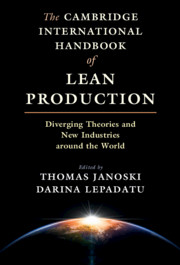 The Cambridge International Handbook of Lean Production
The Cambridge International Handbook of Lean Production Book contents
- The Cambridge International Handbook of Lean Production
- The Cambridge International Handbook of Lean Production
- Copyright page
- Dedication
- Contents
- Tables
- Figures and Sidebars
- Preface
- Acknowledgments
- Contributors
- Abbreviations
- 1 Lean Production as the Dominant Division of Labor
- Part I Theories of Lean Production
- Part II Lean Production across Industries
- 7 Challenges to Lean Implementation from a True Lean Toyota Production System Perspective
- 8 Lean Production in the Automotive Industry
- 9 Product and Process Innovation to Power the Lean Enterprise
- 10 Using a Lean Six Sigma Strategy to Be Resilient in the Telecommunications Sector
- 11 Lean Transformation in Healthcare
- 12 The Adoption of Lean Thinking by Legal Services Providers
- 13 Lean in Public Services
- 14 Mass Merchandizing and Lean Production at Walmart, Costco, and Amazon
- 15 Lean Management Systems and the Use of Financial Information
- 16 Lean Workflow and Quality Assurance when Creating Software-Intensive Products and Services
- Part III Lean Production Around the World
- Name Index
- Subject Index
- References
13 - Lean in Public Services
Focusing on Flow
from Part II - Lean Production across Industries
Published online by Cambridge University Press: 11 March 2021
- The Cambridge International Handbook of Lean Production
- The Cambridge International Handbook of Lean Production
- Copyright page
- Dedication
- Contents
- Tables
- Figures and Sidebars
- Preface
- Acknowledgments
- Contributors
- Abbreviations
- 1 Lean Production as the Dominant Division of Labor
- Part I Theories of Lean Production
- Part II Lean Production across Industries
- 7 Challenges to Lean Implementation from a True Lean Toyota Production System Perspective
- 8 Lean Production in the Automotive Industry
- 9 Product and Process Innovation to Power the Lean Enterprise
- 10 Using a Lean Six Sigma Strategy to Be Resilient in the Telecommunications Sector
- 11 Lean Transformation in Healthcare
- 12 The Adoption of Lean Thinking by Legal Services Providers
- 13 Lean in Public Services
- 14 Mass Merchandizing and Lean Production at Walmart, Costco, and Amazon
- 15 Lean Management Systems and the Use of Financial Information
- 16 Lean Workflow and Quality Assurance when Creating Software-Intensive Products and Services
- Part III Lean Production Around the World
- Name Index
- Subject Index
- References
Summary
From its manufacturing origin, the lean concept has been widely disseminated into services, including public services. The term “lean service” first appeared in Bowen and Youngdahl (1998) to describe how the tools and principles being derived in a manufacturing setting were applicable in a service context. There has since been an increase in the interest in lean service both in practice and in literature, with contributions now being published in top operations management journals (e.g., LaGanga, 2011).
- Type
- Chapter
- Information
- The Cambridge International Handbook of Lean ProductionDiverging Theories and New Industries around the World, pp. 324 - 349Publisher: Cambridge University PressPrint publication year: 2021


